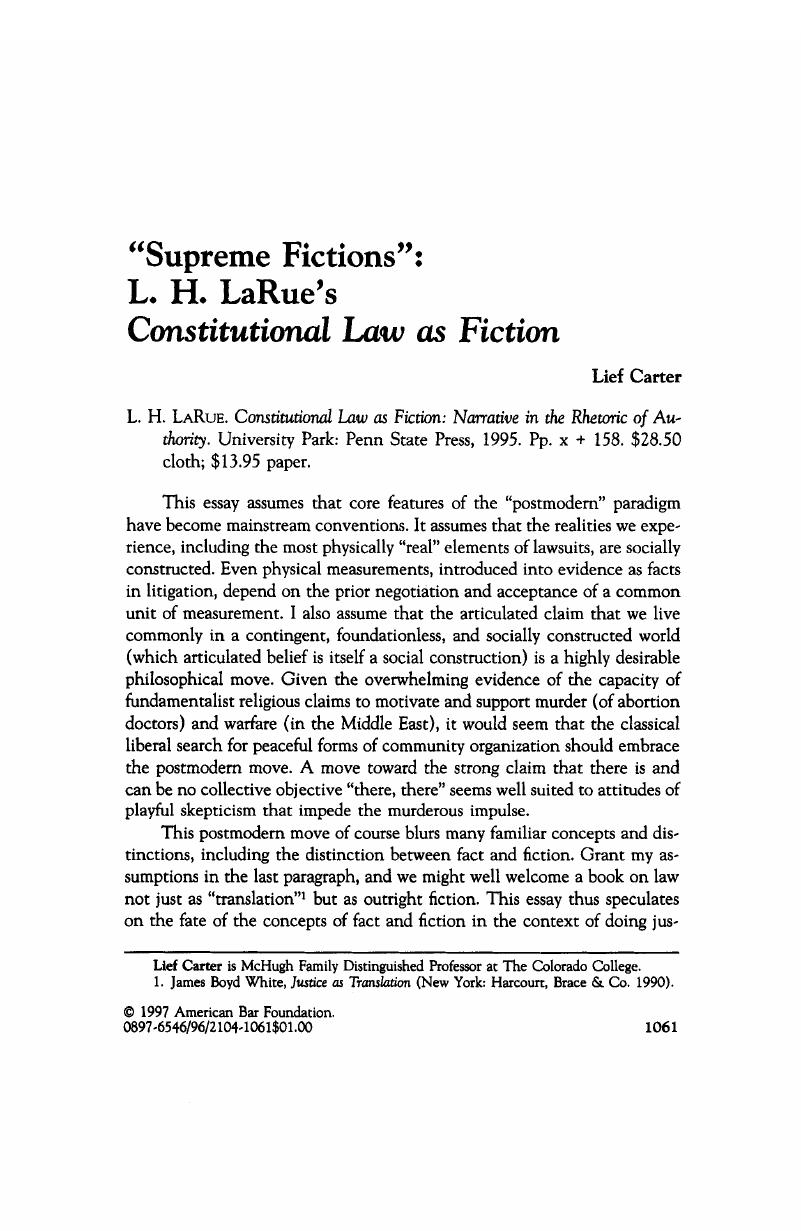No CrossRef data available.
Article contents
“Supreme Fictions”: L. H. LaRue's Constitutional Law as Fiction
Published online by Cambridge University Press: 27 December 2018
Abstract

- Type
- Review Essay
- Information
- Copyright
- Copyright © American Bar Foundation, 1996
References
1 White, James Boyd, Justice as Translation (New York: Harcourt, Brace & Co. 1990).Google Scholar
2 “Professor Sokol's Bad Joke,”N. Y. Times, 21 May 1996, p. A13.Google Scholar
3 Katzenbach v. McClung, 379 U. S. 294 (1964).Google Scholar
4 United States V. Lopez, 115 S. Ct. 1624 (1995).Google Scholar
5 467 U. S. 229 (1984).Google Scholar
6 494 U. S. 872 (1990).Google Scholar
7 478 U. S. 186 (1986).Google Scholar
8 New York: Warner Books, 1993, p. ix. In thinking my way toward writing this essay, I have much benefited from having the excuse to ask many friends-and some virtual strangers-to give me their off-the-top definitions of fiction. For example, a writer in Jackson, Wyorning, replied to my query that the epigraph in Strip Tease says it all.Google Scholar
9 Berger, Peter & Luckmann, Thomas, The Social Construction of Reality (New York: Doubleday & Co. 1966); Thomas Kuhn, The Structure of Scientific Revolutions (Chicago: University of Chicago Press 1970).Google Scholar
10 Quine, W. V., Quiddities 96–99 (Cambridge: Harvard University Press, Belknap Press, 1987).Google Scholar
11 11 (2) Focus on Law Stud., Spring 1996, p. 14.Google Scholar
12 “The Noble Rider and the Sound of Words,”in Allen Tate, ed., The Language of Poetry 91–125 (Princeton, N. J.: Princeton University Press, 1942).Google Scholar
13 The point can be made more formally this way: Indeterminacy in all legal rhetoric (and in literary and poetic rhetorics) is not merely an artificial consequence of constructing a postmodern world. Just the opposite. The observation and experience of indeterminacy (rooted perhaps in our experiencing of Cantor's truth) compel us to reach the illusion of stability and closure through narrative rhetorical devices. This observation in turn makes postmodern theories of knowledge and truth appear more accurate and persuasive than do competing theories.Google Scholar
14 LaRue book thus employs a micro rather than a macro conception of fiction. The book makes no reference to the extensive work distinguishing “fiction” from, say, epic narratives or poetry or dramatic works, nor does it explore how fiction as genre only took the shape we know in the last 100 years. See Wayne C. Booth, The Rhetoric of Fiction (2d ed. Chicago: University of Chicago Press, 1983), and more generally the essays on fiction theory and criticism in Michael Groden & Martin Kreiswirth, eds., The Johns Hopkins Guide to Literary Theory and Criticism 252–68 (Baltimore: Johns Hopkins University Press, 1994).Google Scholar
15 See Stanley Fish, “Rhetoric,”in Frank Lentricchia & Thomas McLaughlin, eds., Critical Terms for Literary Study 203–22 (Chicago: University of Chicago Press 1990), esp. at 212–14, criticizing J. L. Austin's distinction between constative and performative statements, where such constative statements as “He is running,” Austin invalidly claims, do not depend on context. But of course the statement “he is running” does depend on context. Is “he running” for political office? Is the question whether the “he” who is “running” pretending, perhaps by hormonal treatments, to enter a foot race for female contestants?Google Scholar
16 See Fish, Stanley, There's No Such Thing as Free Speech (New York: Oxford University Press, 1994), and Richard Rotty, contingency, Irony and Solidarity (Cambridge: Cambridge University Press, 1989).Google Scholar
17 “Socializing Epistemology,”in McMullin, E., ed., Construction and Constraint 97–122 (Notre Dame, Ind.: University of Notre Dame Press, 1988).Google Scholar
18 City of Richmond v. J. A. Croson Co., 488 U. S. 469 (1989).Google Scholar
19 330 U. S. 1 (1947).Google Scholar
20 See Pollack, John, Contemporary Theories of Knowledge (Totowa, N. J.: Rowman & Littlefield, 1986), chap. 3, “Coherence Theories”: “Coherence theories insist that all beliefs have the same fundamental epistemic status, and the justifiability of a belief is determined jointly by all of one's beliefs taken together.”Google Scholar
21 Athens: University of Georgia Press, 1988.Google Scholar


